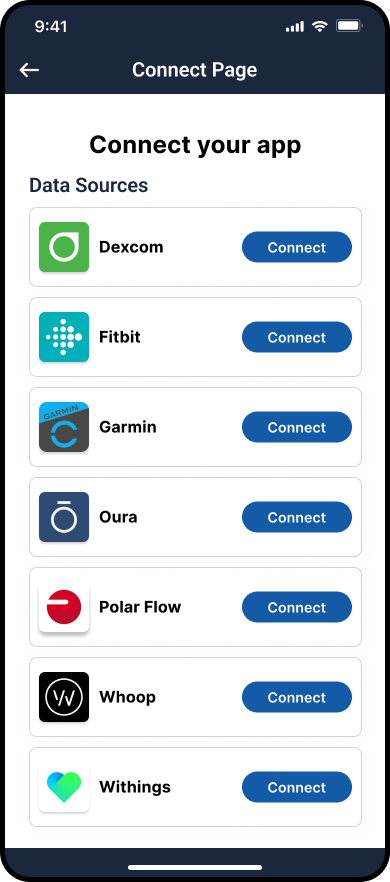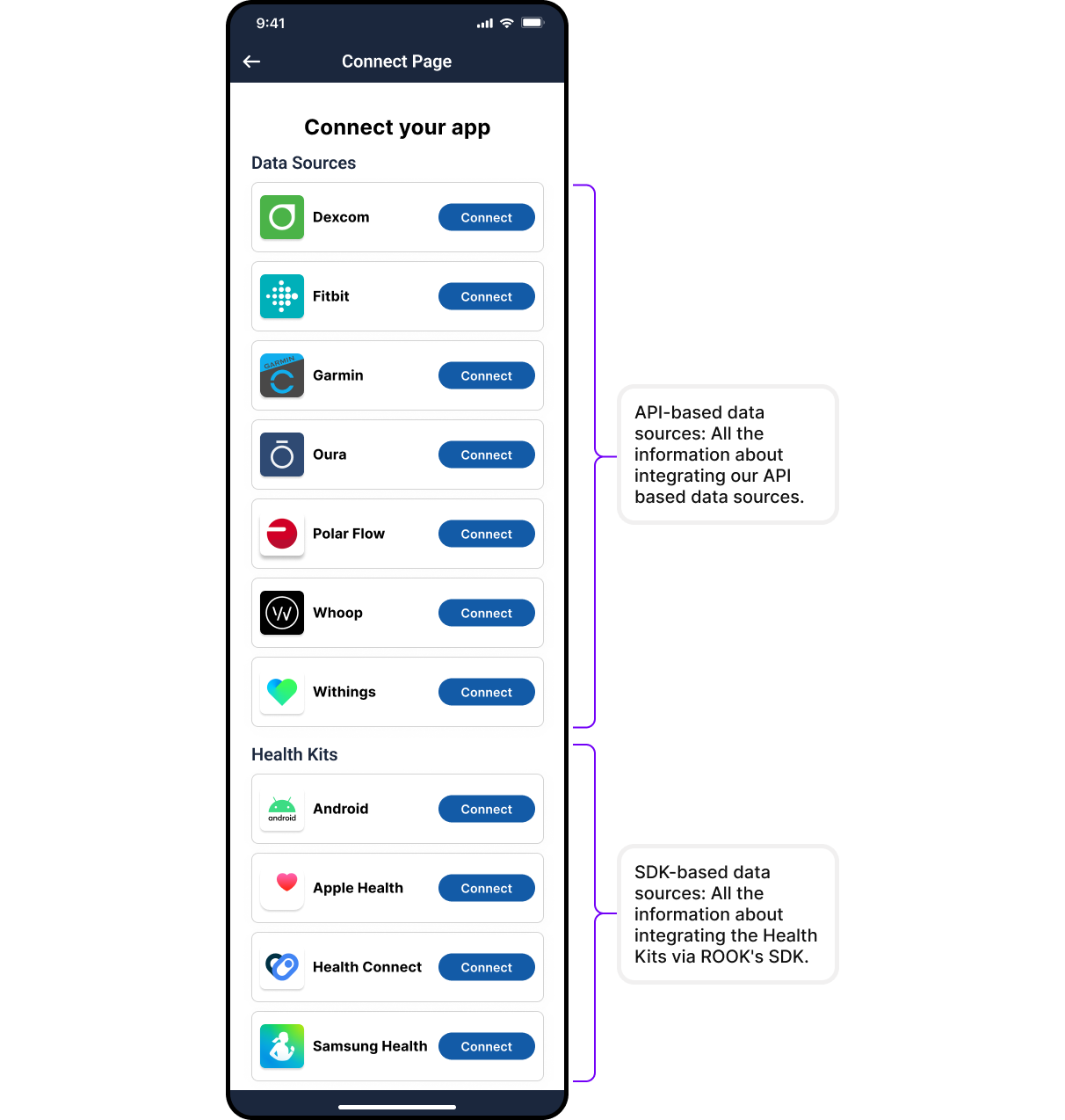Data Authorization
Authorization is the first step to accessing health data through ROOK. Depending on the type of data source, the authorization process varies. This guide explains the two types of authorizations: API-Based Data Sources and Mobile-Based Data Sources, and provides instructions for integrating both.
Overview of Data Authorization
ROOK supports two types of data sources:
- API-Based Data Sources: Platforms such as Fitbit, Garmin, and Oura, where users authorize access via the data source's authorization page.
- Mobile-Based Data Sources: Platforms such as Apple Health and Health Connect, where users grant access directly on their mobile devices.
Both types of authorization enable data extraction and delivery through ROOK.
API-Based Data Sources
For API-based data sources, users authorize ROOK to access their health data via a browser. The setup can be achieved through the following methods:
1. ROOK Connections Page (Sandbox Testing)
ROOK provides a pre-configured ROOK Connections Page for sandbox testing:
- Purpose: Simplifies sandbox testing by offering a ready-to-use webpage for user authorization.
- Configuration: Data sources displayed on the Connections Page can be managed through the ROOK Portal.

The ROOK Connections Page is intended for sandbox testing only. For production, a custom page must be created using the
/authorizer endpoint. See the API Reference for details.
2. Custom Connections Page (Production)
For production environments, a custom Connections Page or app view must be built to handle user authorizations.
Steps to Build a Custom Connections Page
-
Use the
/authorizerEndpoint: Returns the user’s authorization status and, if not authorized, an authorization URL to start the process.Request:
GET /api/v1/user_id/{user_id}/data_source/{data_source}/authorizer
Authorization: Basic {Base64Encoded(client_uuid:secret_key)}Parameters:
- user_id: A unique identifier for the user (1–50 characters).
- data_source: The data source to be authorized. Allowed values: Garmin, Oura, Polar, Fitbit, Withings, Whoop, Dexcom.
- redirect_url (Optional): A custom URL for redirecting users after authorization.
Example Response:
{
"data_source": "Fitbit",
"authorized": false,
"authorization_url": "https://www.fitbit.com/oauth2/authorize?response_type=code&client_id=23R2..."
}infoFor full details, refer to the API Reference.
-
Design the Interface: Create a web page or app view with buttons for each data source. Each button should link to the
authorization_urlprovided by the/authorizerendpoint.Connections View Example:

-
Handle Redirection: After authorization, users are redirected to the callback URL specified in the request. More information on setting up a callback URL can be found in the Callback URL Setup section.
Certain data sources, such as Whoop and Dexcom, require additional integration steps. Contact ROOK Support for assistance.
Mobile-Based Data Sources
For mobile-based data sources, such as Apple Health and Health Connect, authorization occurs directly on the user’s device.
Authorization Process
-
SDKs for Custom Apps: ROOK SDKs can be used to invoke authorization pop-ups that allow users to grant access to their health data.
- Supported platforms: iOS (Apple Health) and Android (Health Connect).
- Integration: The SDK can be added to an app, and authorization functions can be triggered. Details are available in the SDK Documentation.
-
ROOK Extraction App: For clients without mobile development resources, the ROOK Extraction App provides a production-ready solution.
- Users scan a QR code generated via the ROOK API to initiate authorization.
- The app manages data extraction and authorization pop-ups automatically.
More information can be found in the ROOK Extraction App section.
Revoke User Authorization
To revoke ROOK’s access to a user’s health data, the Revoke endpoint can be used:
Request:
POST /api/v1/user_id/{user_id}/data_sources/revoke_auth
Authorization: Basic {Base64Encoded(client_uuid:secret_key)}
Revoking access disconnects the user from all associated data sources for the specified client. If the same account is shared across multiple clients, other clients will retain their access until it is explicitly revoked for each one.
When revoking authorization from a data source, whether through the /revoke-authorization endpoint or directly via the provider’s portal, the process may not be immediate. Some providers may take several hours to complete the revocation, during which data may continue to be temporarily transmitted to ROOK. This behavior depends on the provider and is not controlled by ROOK.
Key Notes
-
Authorization is One-Time: Once authorized, the connection remains active unless explicitly revoked or user permissions change.
-
API-Based vs. Mobile-Based:
- API-based sources require a Connections Page or the
/authorizerendpoint. - Mobile-based sources handle authorization natively via SDKs or the ROOK Extraction App.
- API-based sources require a Connections Page or the
-
Pre-Existing Data Access: Following authorization, ROOK retrieves up to seven days of historical data, enabling immediate insights.
-
Production Readiness: The sandbox Connections Page should not be used in production. Custom pages or app views must be built for production environments.